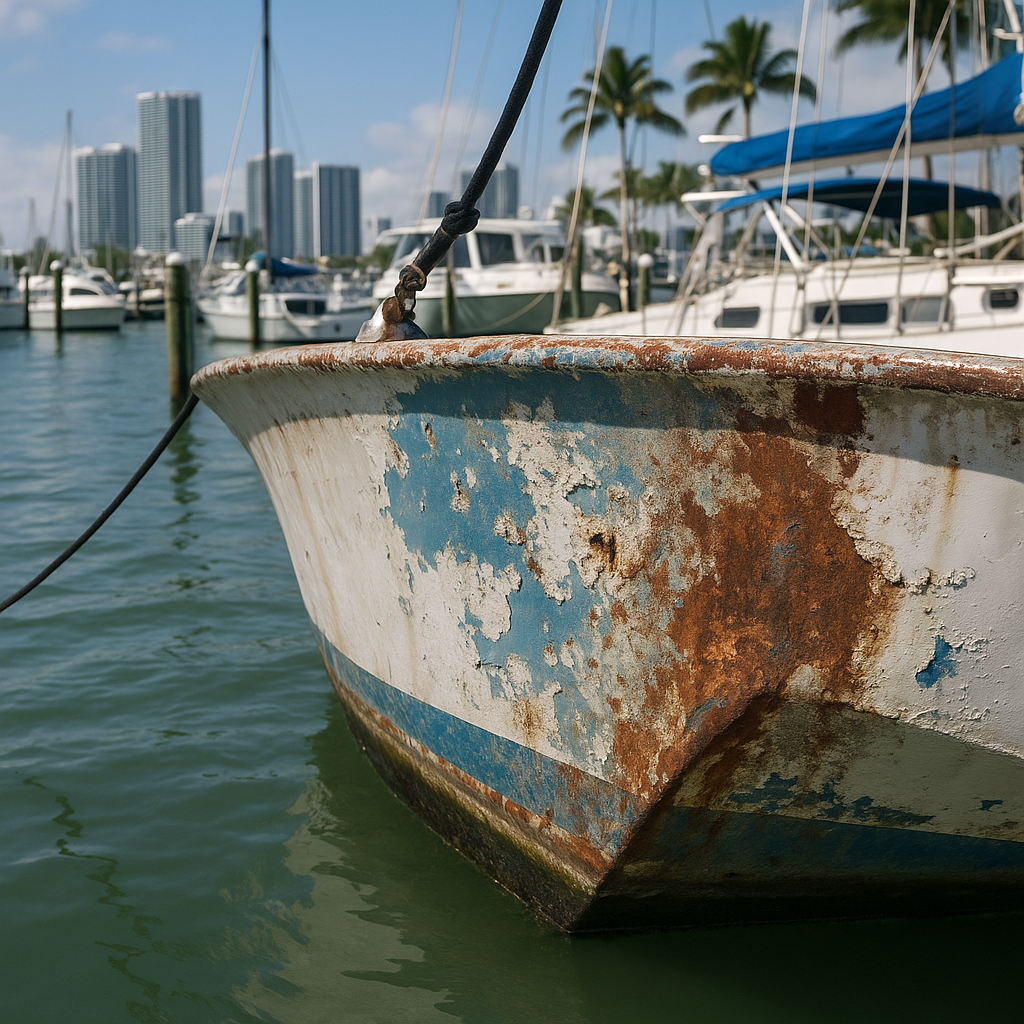Paint jobs don't survive in Miami marinas. The combination of salt, sun, and constant activity creates a perfect storm that strips even the toughest marine coatings down to bare metal. This isn't just about aesthetics - it's about protecting your investment in one of boating's most demanding environments.

The Paradise Tax Hits Your Hull First
Miami's crystal waters and year-round boating weather come with hidden costs. The same tropical conditions that draw boaters from around the world create an aggressive chemical cocktail that attacks hull paint from every angle. The constant assault of UV rays, salt spray, and biological growth means paint degradation happens faster here than almost anywhere else.
Most boat owners discover this reality after their first season. What started as a gleaming finish ends up chalky, faded, and peeling - often within months of application. The culprit isn't poor paint quality or application. It's the unique intensity of Miami's marine environment.
Salt Never Sleeps
The Atlantic's high salinity levels wage a 24/7 war against hull coatings. Salt crystals work their way into microscopic pores in the paint, expanding and contracting with temperature changes. This constant flexing creates weak points where moisture can penetrate, leading to blistering and delamination.
Even boats that rarely leave the dock face this challenge. The salt content in Miami's air means corrosion continues even when your vessel is high and dry. This atmospheric assault accelerates paint breakdown from above while water-borne salt attacks from below. Saltwater damage is a constant concern for local boaters.
- Salt crystals penetrate paint pores
- Temperature changes cause expansion damage
- Atmospheric salt corrodes from above
- Water-borne salt attacks from below
The Living Layer You Can't See
Miami's warm waters create perfect conditions for marine growth. Within days of launching, a microscopic biological film forms on hull surfaces. This biofilm becomes the foundation for larger growth like algae and barnacles, which can penetrate and lift paint from underneath.
The problem compounds in marina environments where limited water circulation and higher nutrient levels accelerate growth rates. What might take months to develop in other locations can happen in weeks in a Miami marina slip. Regular boat cleaning is essential to prevent excessive buildup.
- Biofilm forms within days
- Limited water circulation traps nutrients
- Growth rates exceed normal expectations
- Paint lifting starts from underneath
Traffic Creates Friction
Miami marinas operate at maximum capacity nearly year-round. The constant movement of vessels creates water turbulence that carries abrasive particles. These particles act like liquid sandpaper, slowly wearing away at hull coatings. Add in the occasional bump from neighboring boats or dock structures, and paint damage becomes inevitable.
The problem intensifies during peak seasons when increased boat traffic stirs up bottom sediment. This suspended material contains everything from sand to metal particles, each capable of etching microscopic scratches in paint surfaces. Common boat issues in Miami often stem from this constant friction and abrasion.
Chemical Warfare in the Water
Urban runoff and marina operations introduce a complex mix of chemicals into the water. Fuel spills, cleaning products, and industrial pollutants create a toxic soup that can react with hull paint. These chemical interactions often accelerate paint breakdown or cause discoloration that can't be buffed out.
The concentration of these contaminants tends to be highest in protected marina basins where water exchange is limited. Your hull essentially sits in a chemical bath that slowly degrades protective coatings. Some repairs may be possible on-site, but severe chemical damage often requires professional attention.
Protection Requires Vigilance
Surviving Miami's aggressive marine environment demands a proactive approach to hull protection. The best defense combines proper paint selection with regular maintenance and monitoring. High-quality antifouling paints with enhanced chemical resistance provide better protection, but they're just the starting point.
Success requires understanding that hull protection in Miami isn't a once-and-done proposition. It's an ongoing process of inspection, maintenance, and timely intervention when problems first appear. Year-round maintenance is the key to keeping your hull in top condition.
- Choose paints designed for tropical waters
- Inspect hull conditions monthly
- Address damage immediately
- Schedule regular professional cleanings
- Consider additional protective coatings
The Reality Check
Miami's marine environment will always be tough on hull paint. That's not changing. But understanding these challenges helps boat owners make smarter decisions about protection and maintenance. The goal isn't to fight an unwinnable battle against nature - it's to manage the inevitable wear in a way that protects your vessel's value and appearance.
Those who succeed in preserving their hull paint jobs in Miami marinas aren't lucky - they're prepared. They understand the environment, choose the right products, and maintain consistent vigilance against the forces that would strip their boats bare.
Keep Your Boat Ready for Miami
We know what it takes to keep your boat looking sharp and performing at its best in Miami’s relentless conditions. If your hull paint is showing signs of wear or you want to get ahead of the next challenge, let’s tackle it together. Call us at 305-290-2701 or Request Boat Repair or Service—we’re here to help you stay ahead of the elements.






.png)